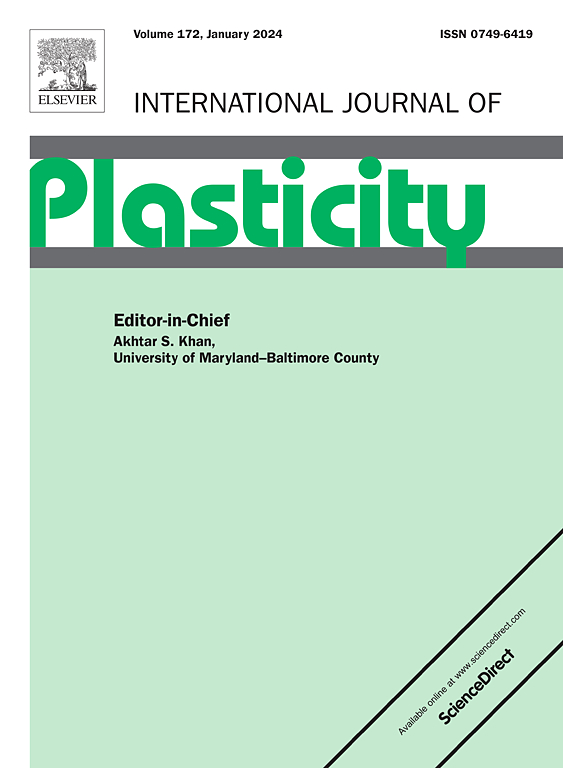Heterointerface-induced stacking fault/dislocation modulation: A way to enhance work hardening and ductility in micro/nano-reinforced aluminum composites
IF 9.4
1区 材料科学
Q1 ENGINEERING, MECHANICAL
引用次数: 0
Abstract
The potential of utilizing bimodal microstructures (including reinforcements and grains) with a high density of heterointerfaces in tailoring defects has not been well understood in particulate-reinforced aluminum matrix composites (PRAMCs). Inspired by this architecture, we developed a micro-B4C/nano-MgO+CNTs-reinforced bimodally-grained 6xxx aluminum alloy composite with tailored internal stress distribution and high-density heterointerface-induced wide stacking faults (SFs). The evolution of linear/planar defect substructures during deformation was studied to explore the microstructural origins of enhanced work hardening and ductility. The novel micro/nano-reinforced composite exhibited significantly higher work hardening and ductility compared to the composite containing only microparticles. This was attributed to multiple heterointerface-induced mechanisms, including hetero-deformation-induced (HDI) hardening, activation of multiple slip systems, Lomer-Cottrell (L-C) locks, and deformation-induced SF networks. These deformation mechanisms allow the composites to exhibit an enhanced strength-ductility combination via in situ reduction of the mean free paths of dislocations. In addition, molecular dynamics (MD) simulation confirmed the high efficiency of l-C locks in pinning dislocations and strengthening. A semiquantitative model was developed to analyze the influence of heterointerfaces on SF width. This study effectively demonstrates the potential of introducing numerous heterointerfaces through bimodal reinforcements/grains, which can be applied to other composites, offering a promising prototype for designing strong yet ductile materials for technological applications via modulating defects.


异质界面诱导的层错/位错调制:一种增强微/纳米增强铝复合材料加工硬化和延展性的方法
在颗粒增强铝基复合材料(PRAMCs)中,利用具有高密度异质界面的双峰微结构(包括增强和晶粒)在剪裁缺陷中的潜力尚未得到很好的理解。受此结构的启发,我们开发了一种具有定制内应力分布和高密度异质界面诱导的宽层错(SFs)的微b4c /纳米mgo + cnts增强双模晶6xxx铝合金复合材料。研究了变形过程中线状/平面缺陷子结构的演变,探讨了加工硬化和塑性增强的微观组织根源。与仅含有微颗粒的复合材料相比,新型微/纳米增强复合材料具有更高的加工硬化性和延展性。这归因于多种异质界面诱导机制,包括异质变形诱导(HDI)硬化、多重滑移系统的激活、lmer - cottrell (L-C)锁以及变形诱导的SF网络。这些变形机制通过原位减少位错的平均自由路径,使复合材料表现出增强的强度-塑性组合。此外,分子动力学(MD)模拟证实了L-C锁在钉钉位错和强化方面的高效率。建立了半定量模型,分析了异质界面对SF宽度的影响。这项研究有效地证明了通过双峰增强/晶粒引入大量异质界面的潜力,这可以应用于其他复合材料,为通过调制缺陷设计坚固而延展性强的技术应用材料提供了一个有希望的原型。
本文章由计算机程序翻译,如有差异,请以英文原文为准。
求助全文
约1分钟内获得全文
求助全文
来源期刊

International Journal of Plasticity
工程技术-材料科学:综合
CiteScore
15.30
自引率
26.50%
发文量
256
审稿时长
46 days
期刊介绍:
International Journal of Plasticity aims to present original research encompassing all facets of plastic deformation, damage, and fracture behavior in both isotropic and anisotropic solids. This includes exploring the thermodynamics of plasticity and fracture, continuum theory, and macroscopic as well as microscopic phenomena.
Topics of interest span the plastic behavior of single crystals and polycrystalline metals, ceramics, rocks, soils, composites, nanocrystalline and microelectronics materials, shape memory alloys, ferroelectric ceramics, thin films, and polymers. Additionally, the journal covers plasticity aspects of failure and fracture mechanics. Contributions involving significant experimental, numerical, or theoretical advancements that enhance the understanding of the plastic behavior of solids are particularly valued. Papers addressing the modeling of finite nonlinear elastic deformation, bearing similarities to the modeling of plastic deformation, are also welcomed.
 求助内容:
求助内容: 应助结果提醒方式:
应助结果提醒方式:


